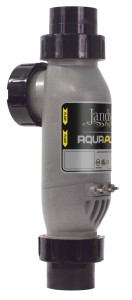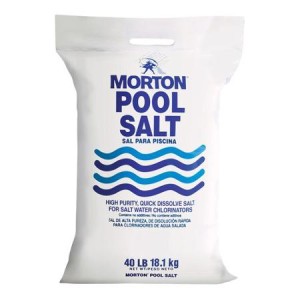The majority of home owners today install a salt chlorinator on their new pool. Even still, people have questions and concerns about the cost, maintenance, and durability of their salt system. The greatest advantage of having a salt chlorinator is automating the process of adding chlorine, thus avoiding the potential of forgetting to add chlorine, causing a drop in sanitization levels and algae blooms.
 However, many homeowners mistakenly believe that once they have a chlorinator installed, they can just let it go. While no panacea, salt-chlorinators definitely reduce the demands on the home owner. There are some critical steps that you must take to ensure the proper function of your pool and chlorinator.
However, many homeowners mistakenly believe that once they have a chlorinator installed, they can just let it go. While no panacea, salt-chlorinators definitely reduce the demands on the home owner. There are some critical steps that you must take to ensure the proper function of your pool and chlorinator.
Use a high quality salt. Not all salt is packaged equal! 99% pure means that you are putting in 1% of an additive that can cause staining. If you add 500 pounds of salt, then you are adding 5 pounds of contaminants into your pool. So buy the highest grade of salt available.
Each 40lb bag of salt is enough to reach the recommend ed concentration of 1500 gallons. So if you have a 15,000 gallon pool, you will need to use ten 40lb bags of salt. A typical salt chlorinator will require a salt concentration of 3500 ppm. This is about 1/10 the concentration of salt in the ocean, barely even perceptible to the taste. Putting in too much salt can make your water corrosive. Many chlorinators automatically shut down if concentrations get to high. To avoid this, when adding your salt, hold back a couple of bags, and then test the concentration. Salt can be added as needed. It is always easier to add salt than to take it away!
ed concentration of 1500 gallons. So if you have a 15,000 gallon pool, you will need to use ten 40lb bags of salt. A typical salt chlorinator will require a salt concentration of 3500 ppm. This is about 1/10 the concentration of salt in the ocean, barely even perceptible to the taste. Putting in too much salt can make your water corrosive. Many chlorinators automatically shut down if concentrations get to high. To avoid this, when adding your salt, hold back a couple of bags, and then test the concentration. Salt can be added as needed. It is always easier to add salt than to take it away!
When you add your salt, do not allow it to sit on the floor of your pool. This can cause a corrosive environment resulting in staining. Keep your pump running and aggressively brush the salt until it is completely dissolved. Preferably, add your salt into the deepest end of your pool.
One of the more common challenges with salt chlorinators is increased scaling. Cloudy water and scaling are a sign your pH is too high. Consistently adding sufficient muriatic acid will prevent scaling. In Arizona, our water is very hard. Taking a water sample into a local pool supply store will also ensure that your water is within an acceptable range of hardness. Over time with evaporation, minerals are left behind and water hardness increases. This is especially true if you have a cartridge filter and aren’t regularly backwashing and replenishing with fresh water.
Inspect your salt cell monthly. Most cells come with an indicator light, notifying you when it is time to check the cell. You should plan on cleaning your cell a couple times a year, by letting it soak in an acid-water solution. That will dissolve the calcium that builds up on the metal plates. Heavy calcification may require multiple or overnight soaks.
If you know from the beginning that your cell has a life of three to five years, you won’t be upset when you have to come up with $500 to buy a replacement cell. Money saved in reduced chemicals should be put away for the purchase of a new cell a few years down the road.
The bottom line: if you are working with a tight budget, and are trying to decide between a water feature and a salt chlorinator, get the water feature. A salt chlorinator can easily be added after market for virtually the same price, whereas the water feature would be more challenging and more expensive to add. A salt chlorinator won’t necessarily save you money over time, but is a great convenience to continuously generate chlorine.
